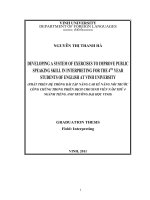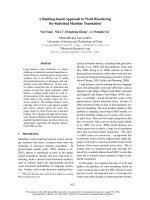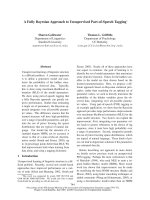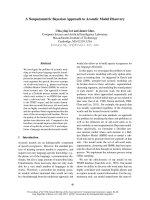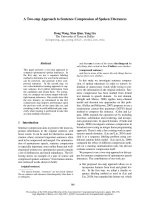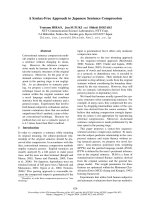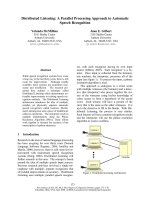Developing a game theory approach to determine optimal loan to cost ratios for construction loans
Bạn đang xem bản rút gọn của tài liệu. Xem và tải ngay bản đầy đủ của tài liệu tại đây (1.67 MB, 100 trang )
VIETNAM NATIONAL UNIVERSITY HO CHI MINH CITY
HO CHI MINH CITY UNIVERSITY OF TECHNOLOGY
PHAN THANH THIEN SON
DEVELOPING A GAME THEORY APPROACH TO
DETERMINE OPTIMAL LOAN-TO-COST RATIOS FOR
CONSTRUCTION LOANS
Major: Construction Management
Major Code: 8580302
MASTER’S THESIS
HO CHI MINH CITY, July 2023
THIS RESEARCH IS COMPLETED AT:
HO CHI MINH CITY UNIVERSITY OF TECHNOLOGY – VNU-HCM
Supervisor 1: Dr. Bui Phuong Trinh
Supervisor 2: Assoc. Prof. Dr. Do Tien Sy
Examiner 1: Dr. Nguyen Hoai Nghia
Examiner 2: Assoc. Prof. Dr. Pham Vu Hong Son
This master’s thesis is defended at HCM City University of Technology,
VNU- HCM City on 10/07/2023
Master’s Thesis Committee:
1 Assoc. Prof. Dr. Luong Duc Long
2 Assoc. Prof. Dr. Tran Duc Hoc
3 Dr. Nguyen Hoai Nghia
4 Assoc. Prof. Dr. Pham Vu Hong Son
5 Dr. Pham Hai Chien
Chairman
Secretary, Member
Reviewer 1
Reviewer 2
Member
Approval of the Chairman of Master’s Thesis Committee and Dean of
Faculty of Civil Engineering after the thesis is corrected
CHAIRMAN OF THE THESIS COMMITTEE
DEAN OF FACULTY OF CIVIL
ENGINEERING
Assoc. Prof. Dr. Luong Duc Long
Assoc. Prof. Dr. Le Anh Tuan
i
VIETNAM NATIONAL UNIVERSITY HO CHI MINH CITY
HO CHI MINH CITY UNIVERSITY OF TECHNOLOGY
SOCIALIST REPUBLIC OF VIETNAM
Independence – Freedom - Happiness
THE TASK SHEET OF MASTER’S THESIS
Full name: Phan Thanh Thien Son
Date of birth: 22/09/1998
Major: Construction management
Student code: 2192015
Place of birth: Ho Chi Minh city
Major code: 858032
I. THESIS TOPIC: DEVELOPING A GAME THEORY APPROACH TO
DETERMINE OPTIMAL LOAN-TO-COST RATIOS FOR CONSTRUCTION
LOANS
ĐỀ TÀI LUẬN VĂN: XÁC ĐỊNH TỶ LỆ KHOẢN VAY TRÊN CHI PHÍ TỐI ƯU
CHO CÁC KHOẢN VAY XÂY DỰNG
II. TASKS AND CONTENTS
Conduct a literature review of existing models and studies pertaining to topic of
optimization of LTC ratio for construction loans
Develop a Game theoretic model to determine the LTC ratio of construciton loans
for different financial objectives based on literature review
Demonstrate model’s mechanics through 1) implementing it for two real-life case
studies in Vietnam and 2) comparing its results to that from existing models
Evaluate model’s effectiveness and conclude thesis with a summary and
suggestions for future research
III. TASKS STARTING DATE: December 2022
IV. THESIS COMPLETION DATE: June 2023
V.
SUPERVISORS: Dr. Bui Phuong Trinh, Assoc. Prof. Dr. Do Tien Sy
HCM City, date . . . . month .. . . year ....
SUPERVISOR 1
SUPERVISOR 2
Dr. Bui Phuong Trinh
Assoc. Prof. Dr. Do Tien Sy
HEAD OF DEPARTMENT
Dr. Le Hoai Long
DEAN OF FACULTY OF CIVIL ENGINEERING
Assoc. Prof. Dr. Le Anh Tuan
ii
Acknowledgements
My family whose encouragement led me to pursue a master’s degree in the first place
and whose support allowed me to persist through difficult times
My professors, thesis instructors - Dr. Bui Phuong Trinh and Assoc. Prof. Dr. Do Tien
Sy, and fellow master’s degree students at HCMC University of Technology whose
guidance and assistance were essential to my academic progress throughout the course
of the program. A special thanks to Dr. Nguyen Thanh Viet whose advice and counsel
were tremendouly valuable to the completion of this thesis.
A special thanks to Professor Jang Ying at California State University, whose guidance
was instrumeantal to the conception of this thesis.
iii
Abstract
The loan-to-cost ratio (LTC ratio) of construction loans are an important
consideration for owners and developers embarking on new development projects who
wish to maximize their financial returns. This thesis proposes a model that solves for
the optimal LTC ratio of construction loans from developers’ point of view for privately
developed and privately financed development projects. The proposed model uses
Game Theory as its main framework along with non-linear optimization algorithms to
determine optimal LTC ratios for construction loans that maximize three different
financial metrics: the expected levered net present value (NPV) of project cash flows,
the expected levered internal rate of return (IRR), and the expected levered return on
equity (ROE).
The model developed in this thesis (hereafter referred to as “the proposed
model”) is based on research and existing models that solve for the optimal LTC ratios
for construction loans as well as studies that incorporate Game Theory for various
problems associated with construction loans. In addition to optimal LTC ratios, the
model also outputs other useful metrics such as the expected levered NPV, expected
levered IRR, expected levered ROE values that it maximizes for, the maximum feasible
construction cost, and the suggested mutually acceptable interest rate. This thesis
therefore contributes to the existing academic literature on the topic of optimal capital
structure by introducing a new tool alongside other existing models that also address
this optimization problem as well as serving as a practical guide for owners and analysts
in structuring their loan terms for negotiations.
Key words: construction loans, loan-to-cost ratio, LTC ratio, Game Theory, non-linear
programming, optimization, expected levered, NPV, ROE, IRR, feasibility analysis.
iv
Tóm Tắt Luận Văn
Tỷ lệ cho vay trên chi phí (tỷ lệ LTC) của các khoản vay xây dựng là một cân
nhắc quan trọng khi các chủ đầu tư muốn tối đa hóa lợi nhuận tài chính của các dự án
phát triển mới. Luận văn này đề xuất một mô hình dùng để xác định tỷ lệ LTC tối ưu
của các khoản vay xây dựng từ góc nhìn của các nhà phát triển đối với các dự án có vốn
đầu tư tư nhân. Mơ hình được đề xuất sử dụng Lý thuyết trị chơi làm nền tảng chính
cùng với các thuật tốn tối ưu hóa phi tuyến tính để xác định tỷ lệ LTC tối ưu cho các
khoản vay xây dựng nhằm tối đa hóa ba chỉ số tài chính khác nhau: giá trị hiện tại rịng
kỳ vọng có địn bẩy (expected levered NPV), tỷ suất hoàn vốn nội bộ kỳ vọng có địn
bẩy (expected levered IRR), và tỷ suất sinh lợi kỳ vọng có địn bẩy trên vốn chủ sở hữu
(expected levered ROE).
Mơ hình được phát triển trong luận án này (sau đây gọi là “mơ hình được đề
xuất”) dựa trên các nghiên cứu và các mơ hình hiện hữu có xác định tỷ lệ LTC tối ưu
cho các khoản vay xây dựng cũng như các nghiên cứu đã sử dụng Lý thuyết trò chơi
trong các nghiên cứu khác liên quan đến các khoản vay xây dựng. Ngoài các tỷ lệ LTC
tối ưu, mơ hình cũng xác định được các chỉ số hữu ích khác như NPV kỳ vọng có địn
bẩy, IRR kỳ vọng có địn bẩy, ROE kỳ vọng có địn bẩy được tối đa hóa, số tiền chi phí
xây dựng khả thi tối đa, và lãi suất được đề xuất mà cả hai bên có thể chấp nhận được
(mutually acceptable interest rate).
Do đó, luận án này đóng góp vào các tài liệu học thuật hiện có về chủ đề tối ưu
hóa cấu trúc vốn (capital structure) bằng cách giới thiệu một công cụ mới trong số các
mô hình hiện hữu được dùng để giải quyết vấn đề tối ưu hóa này cũng như phát triển
một cơng cụ hướng dẫn thực tế cho chủ đầu tư và các đơn vị phân tích tài chính trong
việc thiết lập các điều khoản vay trước và trong khi đàm với bên cho vay.
Từ khóa: khoản vay xây dựng, tỷ lệ vốn vay trên chi phí, tỷ lệ LTC, Lý thuyết trị chơi,
lập trình phi tuyến tính, tối ưu hóa, địn bẩy kỳ vọng, NPV, ROE, IRR, nghiên tích khả
thi
v
AUTHOR’S COMMITMENT
The undersigned below:
Name
: PHAN THANH THIEN SON
Student ID
: 2192015
Place and Date of Birth
: Ho Chi Minh city, 22nd September 1998
Address
: Ho Chi Minh City, Vietnam
declares that the master thesis titled “Developing A Game Theory Approach to
Determine Optimal Loan-To-Cost Ratios for Construction Loans” is completed by
the author under supervision of the supervisors. All works, idea, and material that
gained from other references have been cited in the correct way.
Ho Chi Minh City, June 10th, 2023
PHAN THANH THIEN SON
vi
Table of Contents
Abstract............................................................................................................... iii
Tóm Tắt Luận Văn ............................................................................................. iv
Table of Contents ................................................................................................ vi
List of Figures................................................................................................... viii
1.
Introduction ................................................................................................ 1
1.1 Research Problem ................................................................................... 1
1.1.1 LTC Ratio, Feasibility Analyses, and Financial Analyses .................. 1
1.1.2 Project Performance and Default ....................................................... 2
1.2 Thesis Objectives ....................................................................................... 4
1.3 Scope of Research ..................................................................................... 5
1.4 Significance of Research ........................................................................... 8
1.4.1 Practical Significance ......................................................................... 8
1.4.2 Academic Signficance ........................................................................ 9
1.5 Research Process and Thesis Structure ................................................... 10
2.
Literature Review ..................................................................................... 11
2.1 Construction Loans .................................................................................. 11
2.2 Game Theory ........................................................................................... 13
2.2.1 Theoretical Applicability .................................................................. 13
2.2.2 Advantages Offered by Game Theory .............................................. 15
2.3 Existing Models ....................................................................................... 18
3.
Methodology ............................................................................................ 24
3.1 The Model................................................................................................ 24
3.2 Modelling Assumptions ........................................................................... 26
3.3 The Game ................................................................................................ 27
3.4 Solving for The Optimal LTC ratio ......................................................... 32
3.4.1 Backwards Induction ........................................................................ 32
3.4.2 Expected Levered NPV .................................................................... 32
vii
3.4.3 Mutually-Acceptable Interest Rate ................................................... 34
3.4.4 Abandonment Decision .................................................................... 35
3.4.5 Solving for the Optimal LTC Ratio .................................................. 36
3.5 Flowchart ................................................................................................. 43
3.6 Cash Flow Schedule ................................................................................ 45
4.
Case Studies and Model Comparisons ..................................................... 46
4.1 Case Study 1 ............................................................................................ 47
4.2 Case Study 2 ............................................................................................ 52
4.3 Comparison with Other Models .............................................................. 57
4.3.1 Dias Jr. and Ioannou (1995) ............................................................. 57
4.3.2 Bakatjan et al. (2003) ....................................................................... 66
4.4 Discussion and Evaluation ...................................................................... 72
4.5 Interpreting and Applying The Results .................................................. 74
5.
Conclusion ................................................................................................ 75
References ......................................................................................................... 78
Appendix ........................................................................................................... 81
A. Variables Chart.......................................................................................... 81
B. Abbreviations ............................................................................................ 81
C. Evaluation of Integrals and Sample Excel VBA Code ............................. 82
Expected Levered NPV Evaluation ........................................................... 82
Expected Levered ROE Evaluation ........................................................... 83
Sample VBA Code .................................................................................... 84
D. Equations .................................................................................................. 85
viii
List of Figures
Figure 1.1 - Flowchart showing research process and thesis structure ............................... 11
Figure 3.1 - Game Tree for model ....................................................................................... 31
Figure 3.2 - Relationship between 𝑐̅ ± 𝜃, 𝑐′, and 𝑐̂ ′ ............................................................. 31
Figure 3.3 - Flow chart of game .......................................................................................... 44
Figure 4.1 - Relationship between expected levered NPV and LTC ratio ............................ 51
Figure 4.2 - Relationship between expected levered IRR and LTC ratio ............................. 51
Figure 4.3 - Relationship between expected levered ROE and LTC ratio ............................ 52
Figure 4.4 - Relationship between expected levered NPV and LTC ratio. ........................... 55
Figure 4.5 - Relationship between expected levered IRR and LTC ratio ............................. 56
Figure 4.6 - Relationship between expected levered ROE and LTC ratio. ........................... 56
Figure 4.7 - Relationship between expected levered NPV and LTC ratio ............................ 63
Figure 4.8 - Relationship between expected levered IRR and LTC ratio. ............................ 63
Figure 4.9 - Relationship between expected levered ROE and LTC ratio ............................ 64
Figure 4.10 - Relationship between expected levered NPV and LTC ratio. ......................... 70
Figure 4.11 - Relationship between expected levered IRR and LTC ratio............................ 71
Figure 4.12 - Relationship between expected levered ROE and LTC ratio .......................... 71
Figure C.1 - Sample code written (MS Excel VBA) to determine optimal LTC ratio for
expected levered IRR.......................................................................................................... 84
List of Tables
Table 2.1 - Research from the current literature relevant to the optimization of construction
loans’ LTC ratio ................................................................................................................... 21
Table 3.1 - Discounted Cash Flow Schedule For Each Scenario At Each Time Instance .... 46
ix
Table 4.1 - Case study 1: inputs and assumptions. $M indicates millions USD. .................. 48
Table 4.2 - Summary of optimal LTC ratios for each objective ............................................ 50
Table 4.3 - Case study 2: inputs and assumptions. $M indicates millions USD. .................. 53
Table 4.4 - Case Study 2: Summary of optimal LTC ratios for each objective ..................... 55
Table 4.5 - Variables in Dias Jr. and Ioannou [2] and the corresponding variables in the
proposed model .................................................................................................................. 58
Table 4.6 - Input values for the numerical example in Dias Jr. and Ioannou [2] ................... 58
Table 4.7 - Summary of optimal LTC ratios for each objective compared to Dias Jr. and
Ioannou’s results [2] ............................................................................................................ 62
Table 4.8 - Summary of optimal LTC ratios for each objective compared to Bakatjan et al.’s
results [3] ............................................................................................................................ 62
Table 4.9.1 - Sensitivity Analysis showing effect of changing d and k on l* expected levered
NPV .................................................................................................................................... 64
Table 4.10.1 - Sensitivity Analysis showing effect of changing d and k on l* expected levered
NPV .................................................................................................................................... 69
x
Abbreviations
The following abbreviations are used throughout this thesis:
1. $M – Millions of US Dollars
2. CAPM – Capital Asset Pricing Model
3. DSCR – Debt Service Coverage Ratio
4. IRR – Internal Rate of Return
5. LTC ratio – Loan-to-cost ratio
6. MC(S) – Monte Carlo (Simulation)
7. NPV – Net Present Value
8. PPP – Public Private Partnership (projects)
8.1 BOT – Build-Operate-Transfer (schemes)
8.2 BOO – Build-Operate-Own (schemes)
8.3 ROE – Return on Equity
1
1. Introduction
Construction loans are a major source of financing for large construction
projects, and their loan-to-cost ratios are a major consideration for developers when
structuring and negotiating loan terms as different LTC ratios result in different
financial performances. A review of the current literature shows that existing models
developed for this LTC ratio optimization problem can be further developed as they
either omit certain aspects of the construction loans which may be useful or can be
expanded to include additional financial goals that owners may be interested in. This
thesis aims to develop a model which employs a Game Theory approach to this
optimization problem which would not only expand the existing set of tools available
for this optimization problem but also address some of the areas which existing
models do not cover that would be practically helpful if considered. This section
explores the research problem in greater depth, followed by an outline of the thesis’
scope and a discussion of the significance of the research. This section concludes with
an overview of how the different sections of this thesis are structured.
1.1 Research Problem
1.1.1 LTC Ratio, Feasibility Analyses, and Financial Analyses
The main objective of an owner upon starting a construction project is to
ultimately possess a structure which “looks and functions as intended and that
provides an acceptable return for the money expended” [1]. Therefore, the goal of a
development project in most cases is to maximize financial returns as measured by
metrics such as the Net Present Value (“N.P.V.” or “NPV”), Internal Rate of Return
(“I.R.R.” or “IRR”), and Return on Equity (“ROE” or “R.O.E.”), see [2], [3]. It is
from these financial objectives that other construction-specific objectives, such as
staying on budget and on schedule, are derived [1].
Construction loans, which owners often take out to finance their projects,
affect the cash flow of projects from acquisition to operation [4], which in turn affects
the return metrics on the project. From the developer’s perspective, the LTC ratio
2
directly represents the dollar amount which developers borrow and must repay in the
form of cash inflows and outflows. Therefore, the LTC ratio is a necessary input for
any feasibility analysis that determines the degree to which developers use leverage
in their project, which can theoretically range from 0% (full equity financing) to
100% (full debt financing); the capital structure of the project – the ratio of debt and
equity that is employed – is therefore determined by the LTC ratio. A project therefore
cannot go past the pre-construction phase (where the feasibility and financial analyses
take place) if the owner and lender cannot reach a sufficiently reasonable LTC ratio
that would generate returns that match the owners’ objectives.
The LTC ratio is also an important consideration from the lender’s perspective:
Chan, Wang, and Yang [5] identifies the LTC ratio as one of three main factors which
link construction loan risks to the pricing of construction loans [5]. Without the LTC
ratio as an input, loans cannot be priced (either by the owner or lender), which means
projects cannot be financed and therefore makes them a lot less likely to take place.
Consequently, developers aren’t the only stakeholders who are affected by the
finalized LTC ratio: the interest of lenders, contractors, and public agencies are also
affected.
Furthermore, Dias Jr. and Ioannou [2] demonstrate mathematically that
projects’ ROE and NPV are sensitive to changes in LTC. Hence the determination of
an optimal LTC ratio in order to maximize financial metrics such as ROE or NPV is
not only necessary for a project to happen but also crucial for the owner that he may
maximize his financial returns.
1.1.2 Project Performance and Default
Maximizing financial returns is not the only incentive for the study of
construction loans and their optimal LTC ratios; cost and schedule overruns (often
categorized as “project performance risks” in the context a construction project) can
both be attributed to overleverage in construction projects. Brealey et al. [6] argue
that as construction risk is “partly in the nature of upside risk and partly in the nature
of downside risk”, where upside risks are concerned with maximizing project value
3
through “high-quality, cost-effective, and timely construction”, while downside risk’s
main concern “is the avoidance of delays and cost overruns.” Furthermore, it’s also
argued that equity-holders “will be induced to control upside risk” while debtholders
“will be induced to control downside risk.” As a result, “the relative importance of
these two types of risk should be an important determinant of a project’s leverage”:
projects with higher downside risk tend to be less levered, and vice versa [6].
Sundarajan [7] also identifies the importance of managing capital structures to
ensure cost overruns and schedule delays (“project performance risks”) are mitigated.
As additional capital infusion may be required to manage and control such risks in
the event they do materialize, capital structures may need to be altered in response in
such a way that maximizes the project value. Although Sundarajan [7] is innovative
in this particular research through the use of dynamic capital structure to proactively
manage project performance risks, the inherent relationship between such risks and
their corresponding capital structure remains unchanged.
Moreover, default on construction loans, which are made more likely from
irresponsible lending and from developers borrowing more than what is economically
optimal for them, can have significant impacts on the economy as it has the potential
to create major losses for lenders (the degree of net loss would depend on the amount
recovered from guaranteed assets used or recovered). For example, the S&P Global
Market Intelligence [8] reported over $3Bn in delinquent construction loans across
the U.S. in Q1 of 2020 alone, representing 2.04% of all construction loans on banks’
portfolios. In extreme situations such as in the aftermath of the financial crisis of 2008
up until 2013, the Federal Deposit Insurance Corporation (FDIC) resolved as many
as $39Bn in delinquent construction loans across 144 U.S. banks [9]. While many
factors contributed to the economic bubble and the crisis that ensued, ignorance of
optimal loan ratios, whether willingly or not, prevented lenders and developers from
making sound financing decisions.
As the breadth and depth of the LTC ratio’s importance have been established,
the question therefore naturally arises: how then is the optimal LTC ratio for a project
4
determined? A review of the existing literature shows that although previous studies,
most notably that by Dias Jr. and Ioannou [2] and Bakatjan et al. [3], have developed
models that solve for the optimal construction loan LTC ratio, they all have room for
either improvement or modifications in some aspects, whether it’s the considerations
and assumptions that are included to model the mechanics of construction loans or
the perspectives which they consider. For e.g., some models seek to maximize the
ROE and IRR as the metric to be maximized, while others consider the IRR and the
NPV; while some models consider the sale of the property at the end of the analysis
period, others do not. A more thorough review of these models can be found in section
2.3 of this proposal.
Given the importance of the LTC ratio in the financial analyses of construction
projects, it is worthwhile to enrich the current literature that pertains to modeling its
optimization. This thesis seeks to develop a model that supplements the existing host
of models that deal with this particular optimization problem by proposing the use of
Game Theory as an alternative approach which has yet to be considered from the
perspective of the project owner for this particular optimization problem. Game
Theory as a framework offers several advantages that other approaches employed by
previous models do not for this particular optimization problem, including accounting
for decisions taken by more than one actor (in this case, the lender and
borrower/developer) over the course of more than one time period as well as how
decisions by different actors are affected as new information becomes available. A
more thorough analysis of the strengths of this framework is conducted in section
2.2.2.
1.2 Thesis Objectives
This thesis sets out to achieve the following objectives:
1. Review and analyze the shortcomings and strengths of existing models that
determine the optimal LTC ratio; this is presented in the Literature Review
section.
5
2. Develop a model which determines the optimal LTC ratio using Game Theory;
this will be illustrated in the Methodology section.
3. Demonstrate the mechanics and application of the developed model by
determining the optimal LTC ratios and profitability levels for two case studies
taken from Vietnamese projects, as covered in sections Case Study 1 and Case
Study 2. The model is also compared to two other existing models reviewed in
the Literature Review section. Both the results of the case studies and
comparisons with existing models are detailed in the Case Study and
Comparisons with Existing Models section.
4. Evaluate strengths and limitations of model, suggest areas for its application,
and suggest areas for future research ; this is discussed in the Conclusion
section.
1.3 Scope of Research
The proposed model is intended to facilitate decision making and deal
structuring between lenders, private owners of private projects, including private
investors and private developers, and the specific personnel involved, which includes
but is not limited to
asset managers
project managers
CFOs, investment analysts, and financial analysts
lenders, both local and institutional, and those who work for/under them.
loan originators
loan servicers of different levels
Private owners involved in PPP schemes such as Build-Own-Operate
(BOO) that reserve the right to retain ownership and sell the finished asset.
The model is developed from the perspective of private owners of real estate
development projects who face the decision of whether or not to finance the
construction of their projects with construction loans and if so, how much to borrow.
6
There are several reasons why this model does not assess construction loans in the
case of public projects: firstly, the private sector in most countries is often involved
in building a wider array of buildings, from commercial to industrial to residential,
while public sector projects are largely focused on infrastructure. As a result, the
model when applied to private projects is able to expand its applicability range and
thus theoretically should be more useful.
Secondly, most countries’ private sectors spend a lot more on construction than
their public sectors: for example, the U.S. Census Bureau reported for calendar year
2021 that the private sector’s spending on construction was 3.91x larger than its
public counterpart [10]. The model therefore has greater potential to play a larger role
for the macroeconomy if widely implemented and thus have a more notable impact
when developed with private projects in mind.
Thirdly, as the level of efficiency of public sectors across different countries
is likely to vary due to public sector projects being more closely regulated and often
subject to varying degrees of bureaucracy, red tape, and legislative barriers, it is
difficult for a single model to account for all the differences in the ways which public
sectors across the world approve and manage their construction projects. More
complex and country-specific models would need to be developed in order to
realistically reflect the construction environment and loan practices for a given
country’s public sector, which is different to the direction of general applicability that
this model looks to achieve.
Moreover, from a modelling point of view the dissociation from government
involvement means that certain features that are found in government funded projects
(publicly owned projects, private public partnership (PPP) projects, etc.), including
government guarantees, minimum production requirements, minimum revenues will
not need to be accounted for in the model, see [2]. Additionally, since government
ownership is also not considered, revenue from sale of assets as well as the associated
can actually be modeled as cash flows for the developer himself, rather than simply
considering the project’s inherent market value at completion.
7
The model is constructed to account for the main working principles of a
construction loan, which allows it to reasonably represent contemporary construction
loan practices in most countries and hence ensuring that it achieves a fair level of
applicability across the board with no major adjustments needed for any particular
country. Some of these main working principles include fund disbursement in phases,
interest on loan amount, and the possiblity of the lender recovering some amount of
the loan should the project be abandoned. Furthermore, optimal LTC ratios and
capital structures will be calculated in the context of project financing rather than
corporate financing. This is so that aspects of the model, which is built upon the
original from [5], can be accommodated for, for e.g., the fact that lenders have limited
recourse only to the unfinished construction project should the owner abandon it
before its completion. Secondly, limiting the research to only project financing
removes the need to consider other aspects of corporate financing specific to the
owner’s firm, such as the possibility of commingling of funds.
Mezzanine loans, however, have been omitted from this model because
developers do not always use this type of quasi-debt to finance their projects, and so
their omission would not significantly impact the model’s level of usefulness. The
model will also not analyze loans that also help in financing the acquisition phase of
a lot, a piece of land, or a property in need of renovation, such as construction-topermanent loans. This is because such an analysis would have to extend beyond the
construction phase into the operational phase of the project, which may dilute the
focus of the model from assessing risks and rewards inherent to construction during
the pre-construction and construction stages.
The proposed model will consider three time periods in order to derive the
optimal LTC ratio: at t=0 (during the pre-construction phase) when the developer
performs his feasibility analysis upon being offered by the lender some interest rate
r; the developer chooses a leverage (LTC) ratio l and decides whether to finance his
project entirely with equity or with some amount of debt. At t=1, construction has
already begun under the assumption that some amount of debt was taken on. Up until
8
this point, the lender has released a portion of the full loan (known as the first phase
loan amount), and the market price of the finished project as well as the final total
construction cost is known (but not yet incurred/paid for). At this point the developer
faces the decision to either abandon the incomplete project or continue with it,
regardless of his initial financing decision. At t=2, the owner sells the completed asset
based on the known market price at t=2 and, depending on whether he used debt
financing at the beginning, would have to repay the loan and the interest on it. The
development of this model, including how it is essentially founded on the model by
Chan et al.’s 201 model [5], is thoroughly illustrated in Chapter 3.
1.4 Significance of Research
1.4.1 Practical Significance
The proposed model could be an alternative or could be used alongside other
models that also determine the optimal LTC ratio. In the latter’s case, any major
deviations across the models’ results could be the basis to evaluate not only the
legitimacy of the inputs but also of the models themselves. Both private projects and
PPP projects under schemes such as BOO where the private sector is involved and
does not have to transfer the asset back to its sponsor but instead owns the finished
project and reserves the right to sell it could use the proposed model to determine the
optimal LTC ratio for their feasibility and financial analyses.
Moreover, current software available in the market for financial modelling or
loan sizing can horizontally expand their capabilities by adopting the model
developed in this research and hence provide their users with a wider array of
selection of models to choose from. Other software used by lenders and borrowers to
determine other aspects of construction loans such as interest rate levels, financial
modelling (e.g., ARGUS Enterprise by Altus Group ©), portfolio strength
assessment, ... could also program this model into their software to vertically expand
their software package.
9
1.4.2 Academic Signficance
In theory, it is possible to set up simple financial cash-flowing pro-forma
whereby the user inputs some LTC ratio and then optimizes it through trial and error
or through some add-in function such as Microsoft (“MS”) Excel’s Solver or Goal
Seek. However, such a simple pro forma would not consider the effects of multi-stage
decision making that involves two parties – the lender and the borrower. The reason
why Chan et al. [5] model is used as the basis for developing the proposed model,
despite it being originally developed to find the mutually acceptable interest rate on
a construction loan, is because it allows for the implementation of Game Theory,
which is a particularly novel approach to this optimization problem. While a two
period Game Theory model with two player is able to realistically model the decisionmaking process of both developer and lender over the development life of the project,
non-linear programming is used as an optimization tool that, given the assumptions
and intermediary results (mutually acceptable interest rate and abandonment
decision), calculates the optimal LTC ratio.
The proposed model therefore contributes to expanding the toolset available
to researchers and stakeholders who may need to tackle or would be interested in this
subject. Furthermore, the proposed model builds upon the foundation of other
existing models by identifying both their strengths and what they omit in their
modelling considerations that would’ve been useful or helpful if considered, hence it
serves as a continuation of the existing scholarly conversations rather than as an
addition of something entirely novel.
Since the model’s scope is confined to private real estate projects (as the
characterized by a decision to sell the completed asset at the end of the analysis
period), future researchers could also leverage its framework, particularly its use of
Game Theory, to determine the optimal LTC ratio for the public sector or PPP projects
where public sector funds are taken into account but no sale of the final asset takes
place. The model could also be used to consider debt and equity choices in greater
detail, such as for the use of mezzanine loans.
10
1.5 Research Process and Thesis Structure
This thesis is divided into seven chapters (including the Appendix and
References), each with its own sections and subsections. This thesis begins with an
in-depth literature review of the existing studies that address the optimization of LTC
ratios for construction loans in order to identify relevant models as well as to analyze
their strengths and weaknesses. The literature review section will also look into Game
Theory as an approach to solving different types of problems. The literature review
section concludes with a summary of the findings from these existing studies as well
as an assessment of the strengths and limitations of the developed models.
The thesis proceeds to develop the methodological approach that the proposed
model will incorporate by analyzing components of the proposed model, modelling
assumptions, and how the optimal LTC ratios will be calculated. Next, the model’s
mechanics will be demonstrated through two case studies; its effectiveness will also
be compared with two other existing models by calculating its own set of results based
on the input data from the examples included in the research from which these two
existing models were developed. After that the results from the case studies and
comparisons with the other two models will be discussed and evaluated. Finally, the
thesis closes with a conclusion and suggestions for further research. Figure 1.1 below
outlines the research process in this thesis.
11
Figure 1.1 - Flowchart showing research process and thesis structure
2. Literature Review
2.1 Construction Loans
A review of construction loans in the existing literature is important as it
provides insight into how they work and the different aspects that may be important
for modelling them. Zhang et al. [11] categorizes construction project financing into
three main sources: debt, equity, and quasi-equity (such as mezzanine loans).
Construction loans are an important source of debt financing in many construction
projects: Vu et al. [12], for example, identifies construction loans as one of the main
sources of debt financing in public infrastructure projects in Vietnam. Such loans
come in multiple different forms, including “ADF concessional loans, OCR ordinary
loans and national debt securities.”
Construction loans contain certain features that make them different from
other types of loans. Chan et al. [5] points out that construction loans are often
12
disbursed in periods, unlike with mortgages when a lump sum is released to the
borrower at loan closing. Chan et al. [5] and Ross et al. [9] both point out that the
project itself is often the collateral for the loan; as a result, the collateral is in essence
being created as the loan matures and the project progresses, and is particularly
significant to lenders as default or abandonment mid-project exposes the lender to a
greater risk as incomplete projects are not only much more difficult to value but also
do not have cash flows available to offset and debt obligations during the loan period.
This raises the issue of structuring loan recourse from both the lender and
borrower’s perspective, which is an important consideration for structuring loan
terms and setting interest rates. In the case of the degree of recourse on the loans, on
one hand researchers such as Chan et al. [5] and Ross et al. [9] indicate that “some
lenders request the developer to be personally liable for the construction loan or
provide some other properties as additional collateral” so that borrowers “provide
some “skin-in-the-game” on the part of the borrower, if the value of the raw land or
partially built project that is pledged as collateral is not sufficient.”
On the other hand, researchers such as Hainz and Kleimeier [12] and Esty [13]
point out that in the context of infrastructure project financing (rather than corporate
financing) through independent legal project entities, “liability is limited such that
the lenders have no or only limited recourse to the sponsoring firms”. From this we
see that since there is in practice room for the lender to recover some portion of the
loan in the form of limited recourse (rather than pure non-recourse or pure recourse
agreements) through either project financing, corporate financing, or from the value
of the incomplete project, this proposed model will also account for such limited
recourse in the form of some level of recovery of the construction from the
persepective of the lender and the borrower, which will be reflected in their cash
flows, most notably that of the developer/borrower.
Very few studies have been conducted that are directly or loosely relevant to
the topic of commercial construction loans in Vietnam. Le et al. [14] investigated the
effect on investors’ returns of two different debt repayment schedules of a
13
construction loan taken out to finance the Son La hydropower plant in Vietnam. An
earlier and more distantly related study by Dang and Huynh [15] uses statistical
methods to analyze the effect of portfolio diversification on Vietnamese banks’
financial returns. Topics centering or surrounding construction loans in Vietnam,
therefore, seem to receive very little attention, particularly in the commercial context
(rather than in residential projects).
2.2 Game Theory
2.2.1 Theoretical Applicability
In order to develop a model for any type of optimization problem (in this case,
the optimization of the LTC ratio for a construction loan), it is essential that a
foundational framework is first established or identified. The choice of a suitable
framework is based on the evaluation of its “appropriateness, ease of application, and
explanatory power” for the intended research purpose, which in this case is to model
and find construction loans’ optimal LTC ratios [16]. It is therefore necessary to
analyze the mechanics and environment in which such loans and their corresponding
development projects take place in order to select a suitable framework to approach
the optimization problem.
It is observed that different LTC ratios result in varying levels of return for
different financial metric of interest (for e.g., the levered IRR of a project). Therefore,
the developer during the feasibility analysis and financial analysis phase essentially
chooses for the LTC ratio which is expected to result in financial returns that meets
or optimizes for one or more financial metric targets. Tadelis [17] characterizes such
kinds of situations as belonging to the category of decision problems, which consist
of three main characteristics: 1) actions - options which the decision makers can
choose from; 2) outcomes – the results corresponding to the actions that are taken,
and 3) preferences – the decision maker’s perceived desirability of the outcomes
relative to each other [17]. When applied to the case of a developer choosing the LTC
ratio for that loan, his actions would be the selection of the different possible LTC
ratios; his outcomes would be the financial returns he gets from each LTC ratio given
